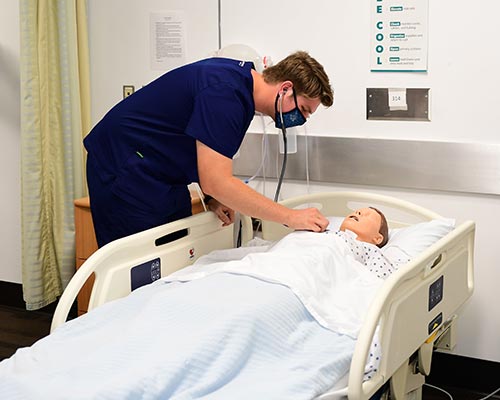PA Clinical Year Details
As you consider your role as a PA (Physician Assistant) preceptor, we encourage your review of the clinical year details to see how your practice can play a part in this experience.
Overview
The 11 months of the clinical year are divided into 9 four-week rotations, interspersed with several weeks of additional didactic education related to professional issues in their Masters Seminar courses. Students are assigned to a rotation site for a four-week rotation where they are expected to work alongside the preceptor.
The clinical year is designed and organized across ambulatory, inpatient, emergency, and surgical settings and intended to expose the students to clinical experiences across the lifespan and variations of acuity.
Each student is required to complete the following clinical rotations:
*The elective rotations will include other disciplines and specialties in medicine that students select according to their interests or are assigned based on availability.
During clinical rotations, students learn the body of knowledge and clinical skills of each discipline within the framework of the healthcare team and PA role. With the guidance and supervision of physicians, PAs, and other qualified preceptors, students gain increasing levels of clinical skill and confidence.
As the clinical year progresses, students are exposed to variety of practice settings (including rural, inner city, and medically underserved communities) and patient types such that they are able to take on more and more aspects of patient care, disease management, and medical decision-making. The PA program also provides structured learning activities and timely feedback to the students during and at the end of each rotation.
Students assume increasing responsibility for the following as they progress through the clinical year:
- Their education (including self-assessment, critique, and remediation)
- Provision of patient care
- Functioning as a team member
- Adjusting to change in the healthcare system
- Practice of evidence-based medicine
- Becoming lifelong learners

Student Preparation & Credentialing
Cedarville University PA students undergo 13 months of intense didactic experiences that cover the basics of anatomy, pathophysiology, and medical sciences, applying them to the understanding of clinical medicine and surgery, history taking and physical exam courses, and the discovery and application of current medical literature in an evidence-based manner.
Students also undergo extensive health screening and hospital training for addressing compliance issues according to state and federal guidelines. The training and screening include HIPAA, personal protective equipment, and sterile technique training. Immunization verification to include Hepatitis B, current annual TB skin test, and recent criminal background check and drug screen are also completed on each student.
Once a student is confirmed to rotate with a preceptor or site, proof of this preparation and credentialing is provided to the preceptor/site from the program and the student.
Objectives & Outcomes
For each required rotation, the program identifies and defines a set of learning objectives. Objectives and expectations (including minimum exposures) related to each rotation are included in the syllabi and communicated directly to the preceptors as part of their onboarding. These expectations are not meant to be all-inclusive but rather form a matrix of minimum exposure with which the student must be familiar or have completed during the clinical year.
In so much as the practice of medicine is an ever-changing and developing discipline and that these expectations are created in theoretical framework, we welcome feedback and input on these objectives and outcomes regarding their applicability to actual learning environment and experiences. Feedback from preceptors, students, and alumni inform our annual review of the clinical year objectives.

















